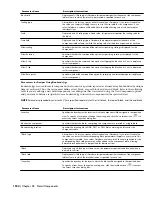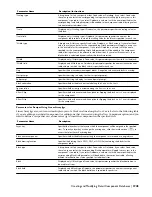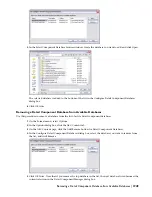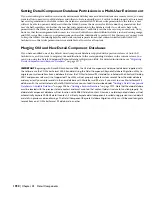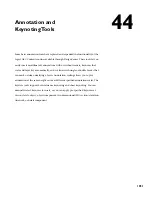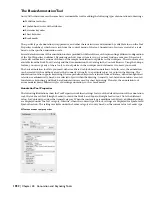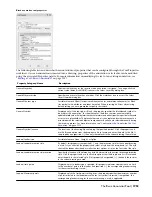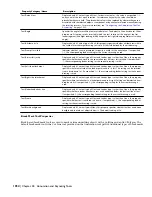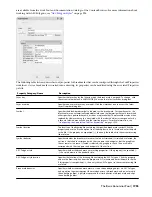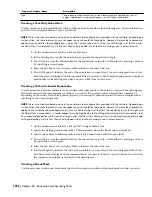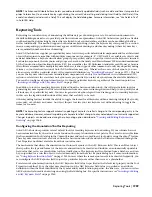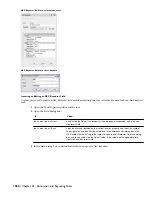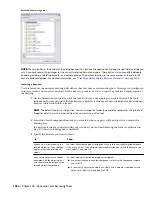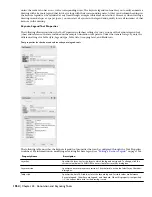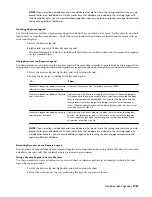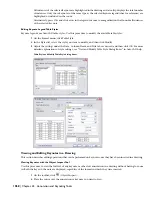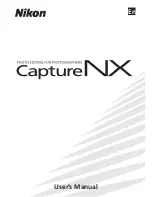
Block annotation tool properties
The following table lists and describes the annotation tool properties that can be configured through the Tool Properties
worksheet. Once an annotation is inserted into a drawing, properties of the annotation or its leader can be modified
using the associated Properties palette. For more information on modifying the text of an existing annotation, see
“
Editing a Text-Based Annotation
” on page 1957.
Description
Property Category/Name
Specifies the layer key for the layer to which annotation is assigned. To change, click the
current value (default is ANNOBJ) to access the Select Layer Key dialog box.
General/Layer key
Specifies one or more layer key overrides. Click the worksheet icon to access the Select
Layer Overrides dialog box.
General/Layer override
Possible values are Mtext (for basic multiline text notes and reference keynotes) or Block
(for symbols with attributes and sheet keynotes). When inserting an Mtext object using
default settings, you are prompted to specify text width.
General/Content type
Displayed only if Content type is Block, this property specifies the block-based symbol to
be used for the annotation. For sheet keynotes, the block contains an automatically
updatable field value that determines keynote format and either specifies a particular keynote
or serves as a placeholder. The placeholder value is then replaced by whatever keynote is
associated with the selected object or component or by a keynote selected manually during
the insertion process. For more information, see
“
Configuring the Annotation Tool for
Keynoting
” on page 1959
.
General/Symbol
The location of the drawing file containing the specified symbol. Click the property and
use the Browse option from the drop-down list to locate and enter the path to the file. If
this property is unspecified (--), then only those blocks in the current drawing file are listed.
General/Symbol location
Possible values are None, Straight, or Spline.
Leaders/Leader type
By default, this property is unspecified (--), and the dimension style for the current drawing
is used. Or you can click the property and select a style from the drop-down list. The style
controls the leader arrow head as well as the text options as set on the Text tab of the style.
Leaders/Leader dimension style
Specifies the location of the dimension style if different from the current drawing dimension
style. Click the property and use the Browse option from the drop-down list to locate and
enter the path to the selected style. If this property is unspecified (--), then only those styles
in the current drawing are used.
Leaders/Leader dimension style location
Displayed only if a leader type is specified, this property indicates whether there is a limit
to the number of points in the leader. If unspecified (--), the corresponding leader setting
for the current drawing is used.
Leaders/Limit points
Displayed only if the Limit points setting is yes, this property specifies the maximum number
of points allowed in the leader before the text or symbol is inserted. If unspecified, the
corresponding leader setting for the current drawing is used, if applicable.
Leaders/Maximum points
The Basic Annotation Tool | 1953
Summary of Contents for 00128-051462-9310 - AUTOCAD 2008 COMM UPG FRM 2005 DVD
Page 1: ...AutoCAD Architecture 2008 User s Guide 2007 ...
Page 4: ...1 2 3 4 5 6 7 8 9 10 ...
Page 40: ...xl Contents ...
Page 41: ...Workflow and User Interface 1 1 ...
Page 42: ...2 Chapter 1 Workflow and User Interface ...
Page 146: ...106 Chapter 3 Content Browser ...
Page 164: ...124 Chapter 4 Creating and Saving Drawings ...
Page 370: ...330 Chapter 6 Drawing Management ...
Page 440: ...400 Chapter 8 Drawing Compare ...
Page 528: ...488 Chapter 10 Display System ...
Page 540: ...500 Chapter 11 Style Manager ...
Page 612: ...572 Chapter 13 Content Creation Guidelines ...
Page 613: ...Conceptual Design 2 573 ...
Page 614: ...574 Chapter 14 Conceptual Design ...
Page 678: ...638 Chapter 16 ObjectViewer ...
Page 683: ...Designing with Architectural Objects 3 643 ...
Page 684: ...644 Chapter 18 Designing with Architectural Objects ...
Page 788: ...748 Chapter 18 Walls ...
Page 942: ...902 Chapter 19 Curtain Walls ...
Page 1042: ...1002 Chapter 21 AEC Polygons ...
Page 1052: ...Changing a door width 1012 Chapter 22 Doors ...
Page 1106: ...Changing a window width 1066 Chapter 23 Windows ...
Page 1172: ...1132 Chapter 24 Openings ...
Page 1226: ...Using grips to change the flight width of a spiral stair run 1186 Chapter 25 Stairs ...
Page 1368: ...Using the Angle grip to edit slab slope 1328 Chapter 28 Slabs and Roof Slabs ...
Page 1491: ...Design Utilities 4 1451 ...
Page 1492: ...1452 Chapter 30 Design Utilities ...
Page 1536: ...1496 Chapter 31 Layout Curves and Grids ...
Page 1564: ...1524 Chapter 32 Grids ...
Page 1611: ...Documentation 5 1571 ...
Page 1612: ...1572 Chapter 36 Documentation ...
Page 1706: ...Stretching a surface opening Moving a surface opening 1666 Chapter 36 Spaces ...
Page 1710: ...Offsetting the edge of a window opening on a freeform space surface 1670 Chapter 36 Spaces ...
Page 1956: ...1916 Chapter 42 Fields ...
Page 2035: ...Properties of a detail callout The Properties of a Callout Tool 1995 ...
Page 2060: ...2020 Chapter 45 Callouts ...
Page 2170: ...2130 Chapter 47 AEC Content and DesignCenter ...
Page 2171: ...Other Utilities 6 2131 ...
Page 2172: ...2132 Chapter 48 Other Utilities ...
Page 2182: ...2142 Chapter 51 Reference AEC Objects ...
Page 2212: ...2172 Chapter 52 Customizing and Adding New Content for Detail Components ...
Page 2217: ...AutoCAD Architecture 2008 Menus 54 2177 ...
Page 2226: ...2186 Chapter 54 AutoCAD Architecture 2008 Menus ...
Page 2268: ...2228 Index ...






